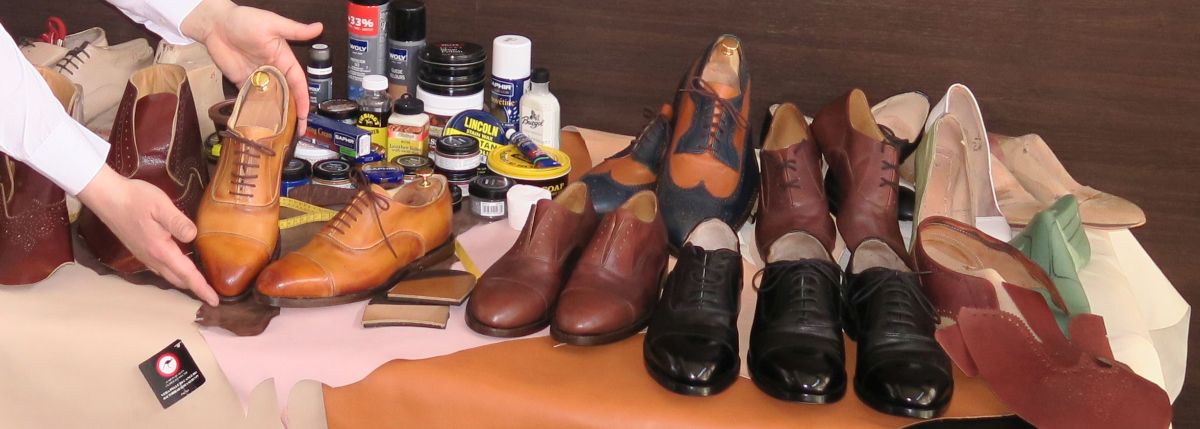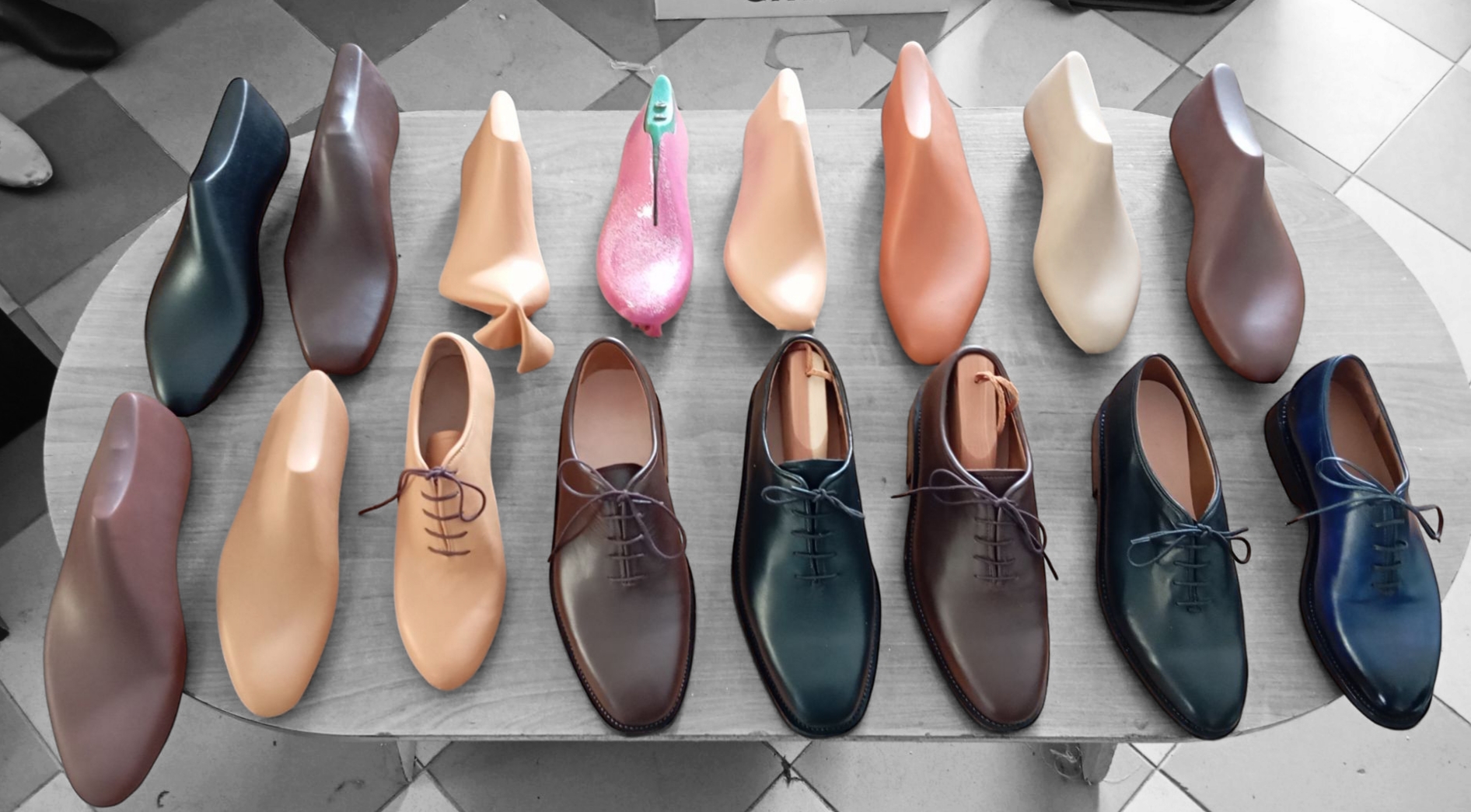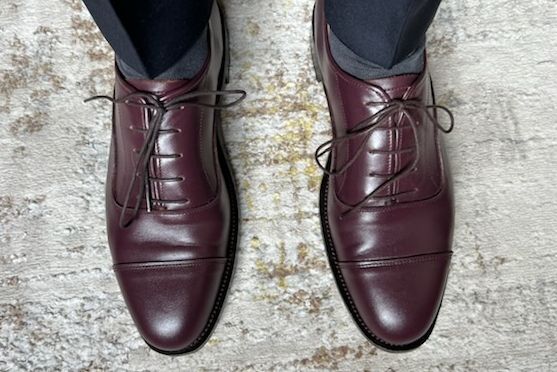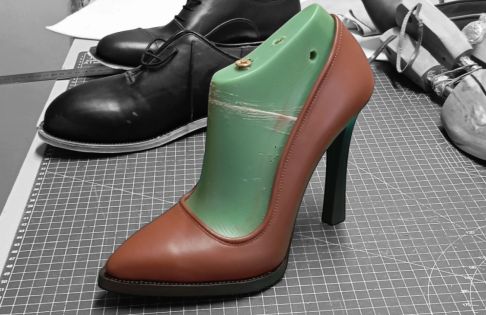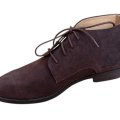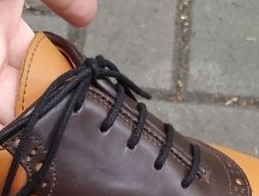Wersja po angielsku
How to measure your feet:
When making bespoke shoes, we can measure your feet in person, when you visit us personally or use measurement provided by you. Since we always prepare trial shoes first, there is no risk that the measurements sent via email will negatively affect the final product. Whether we take the measurements or the client follows the instructions in this post to measure their feet by themselves, the final adjustments will always be made on the trial shoes. We encourage you to place an order for a bespoke pair in our workshop, and below you can find instructions on how to measure your feet from the comfort of your house.
BESPOKE SHOES - TAKING THE MEASUREMENT
This post provides instructions for taking the measurement for bespoke shoes. To do this as accurately as possible, it is very useful to have an assistance of another person who will perform the actions described below and take appropriate photographic documentation.
The basic rule is that a person whose foot is being measured sits still and does not move their feet during the measurement. Once the outline of the feet is traced on the sheets of paper, the feet cannot be lifted off the surface of the paper or moved in any other way. It’s very important to remain still until tracing of the feet is completed.
Taking Measurement - Step by Step guide:
The person whose feet are to be measured should sit on a chair at a height where the knee is at a right angle (it should form 90 degrees give or take). The foot should be pointing straight ahead and not tilted outwards. From the moment the measurement begins, the only permissible movements are minimal lifting of the toes or forefoot to allow the person taking the measurement to slide the measuring tape.
The person who is taking the measurement should use a pencil/pen to outline the feet. To do this, the pen should be held in a vertical position, slightly tilted outward, so that the outline of the foot reflects its shape as accurately as possible. From the back of the heel, along the outer side of the foot and toes, this is relatively easy to do as the foot closely adheres to the surface. The question may arise as to how to make the outline from the inside, that is, the longitudinal arch. At this point, the foot does not adhere to the surface, and this is actually a very valid question. To manage this a pen should be guided similarly to what we did with other edges, possibly slightly increasing the angle, i.e., going a little deeper under the foot. Since we make shoes that are very well fitted, this part of the foot will be partially covered by the shoe upper, and it can also be corrected after making the trial shoe. So do not be alarmed.
Once the outline of the feet is complete (the person being measured does not move their legs), we move on to taking measurements. An essential element of this process is simultaneously taking photos of the measuring tape applied to the foot. This is because only in this way will we know exactly where the measurement was taken, how the tape was applied, and what anatomical features the foot has.
The basic measurement involves measuring the foot at key points:
• at the height of the halluxes
• in the arch
• circumference through the ball of the foot
• in the circumference passing through the ball and the base of the heel at the back
• circumference passing through the ankle and the ball of the foot
To take the measurement, we perform the following steps:
We slide the measuring tape under the foot and try to choose the widest point at the level of the big toe. On the foot outline which we previously made, we mark the place where the tape is applied on both the left and right sides. It is a good idea to do this by drawing two lines at the point where the tape is located, simply marking its width. We then wrap the foot with the tape so that the foot is lightly compressed by the tape, or in other words, so that the tape fits very precisely to the foot. We read the measurement result and record it at one of the tape application points on the foot outline(basically we write the measurement down to either side of the foot). When writing down the measurements, we keep the tape on the foot without moving it. After recording the measurement, we take photos that show the ruler's markings, the place where the tape was applied to the foot, and how it was led.
After taking the measurement at the height of the hallux, we take a measurement at the point of the instep. We perform the same steps as before. It may be more difficult to determine the exact point of measuring with this measurement, but it's not a problem because with the photos and marked points of measuring tape on the foot outline, we will be able to transfer the measurement to the corresponding point on the hoof.
The circumference around the foot arch is taken at the highest point of the foot. When taking the measurement, we try to place the measuring tape perpendicular to the ground.
The circumference around the heel and foot arch is the circumference of the shoe collar in the upper part. When taking the measurement, we should not pull the measuring tape too tightly, so as not to create a straight measurement line, but instead we should lead the tensed measuring tape on a slight curve.
The last measurement involves taking the circumference around the back of the heel and the upper part of the arch. Unlike previous measurements where the person being measured could assist by sliding their foot onto the measuring tape, in this case, they must remain completely still. The foot should be firmly pressed against the ground. The person taking the measurement should slide the measuring tape firmly under the heel as shown in the illustration below. Then, the tape should be guided around the arch of the foot, passing through the highest point of the arch, which is typically where the last eyelet of the laces is located. As with the previous measurements, it is important to document the measurement with photographs.
Taking foot measurements - photos.
After taking the measurements, we put the measuring tape aside and take photos of the feet. What do we want to see? All anatomical features, such as any kind of swelling, bumps, protruding bones, heel spurs, etc. This is an equally important element as taking the measurements themselves, because based on such photos, we can include appropriate relief or stabilization areas on the prepared last. We take two sets of photos - with socks on and bare foot.
Bespoke shoes - personal ideas and suggestions.
In other words, everything that will allow us to learn more about what cannot be inferred from just the measurements or photos. Desired information includes, for example, whether the foot tends to swell, any particularly sensitive areas, as well as information about the shoes that you have been using so far, specific brands, models, any problems with these shoes, etc.
